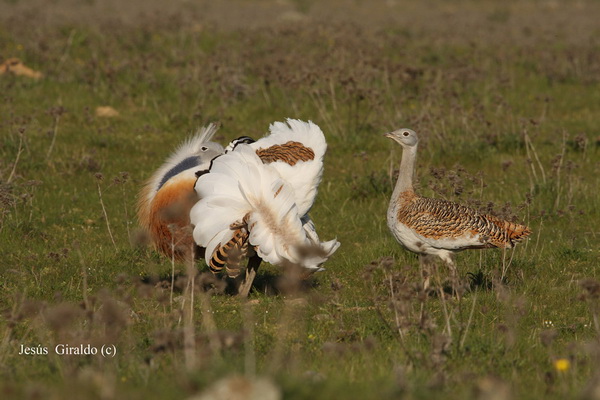Wedding dance of a males starts in the middle of March or early April and lasts until the beginning or the end of May. Breeding period starts with separating into pairs, the sex ratio is 1:1. Wedding dance takes place early in the morning, and then again in the afternoon, but with less intensity. The wedding dance basic appearing is : strutting of a male Bustard. Great Bustard' s nest is a small dent in the ground, with a few blade of grass and feathers. The nest can be located in a thick grass, and also next to a road, on a display. Nowadays, in the conditions of intensive agriculture, distribution of nests in some way depends on the crops that dominate in certain areas, which are mostly grains and legumes. the nests can be found on the land with sparse vegetation cover.

Great Bustard lays the eggs mostly in May, depending on weather conditions. The distance between two nests is 80 - 100 meters.Female lays one to three eggs. Between laying two eggs goes 24 to 28 hours. An egg of a Great Bustard is big. The average weight is 110 - 170 grams. The basic color of an egg is light oil - green, in some cases brown, and even light blue. A basic color is, by rule, light with darker, brown spots. Some authors indicate that the blue egg is the first egg of a young female. The other eggs in the same nest have regular color.
Female is brooding from 25 to 28 days, until the young hatch, leaving the nest 1 - 3 hours a day . During this time, the male approaches the nest, but doesn't participate in the hatching. As egg incubation is coming to an end, the female rarely leaves the nest, lowering the chance to of putting the eggs in danger, so it can happen that man literally steps on the bird.
The biggest enemies of a Great Bustard are grey crowns. While sitting on a nest, Great Bustard successfully defends the eggs, but the damage is done when a female leaves a nest.
It takes a long time for young birds to come out of the eggs. From time when the shell cracks, till the young birds come out, it takes from 12 to 36 hours. For 5 to 8 days a female is directly feeding and giving water to the young birds. A female takes care of them by herself. If they are in danger, a female almost never leaves them, she starts flying to deceive an enemy.
Young birds grow fast. It takes 7 or 8 days for them to get feathers. In the autumn months, a female with her chicks goes with a rest of the flock.



